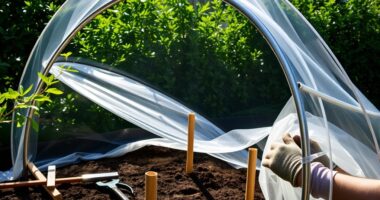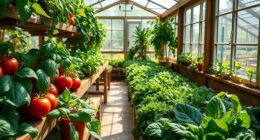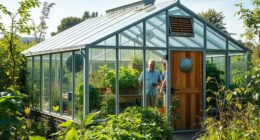When choosing a foundation for your greenhouse, consider gravel beds for good drainage and simple DIY setup, or opt for a concrete slab for stability and durability. Pier and beam foundations elevate your structure to prevent moisture issues, while wood frames are budget-friendly and customizable for smaller setups. Raised beds and modular bases offer easy installation and excellent water control. Keep exploring to find the foundation that best suits your climate and project needs.
Key Takeaways
- Gravel beds promote drainage, aeration, and prevent waterlogging, making them ideal for DIY greenhouse foundations.
- Concrete slabs provide stable, durable bases but require soil testing and proper drainage planning.
- Pier and beam foundations elevate the structure, reducing moisture issues and improving ventilation.
- Wood frame and skid foundations are cost-effective, customizable, and suitable for small to medium greenhouses.
- Raised bed and modular foundations simplify soil prep, enhance drainage, and facilitate maintenance and climate control.
Gravel Bed Foundations
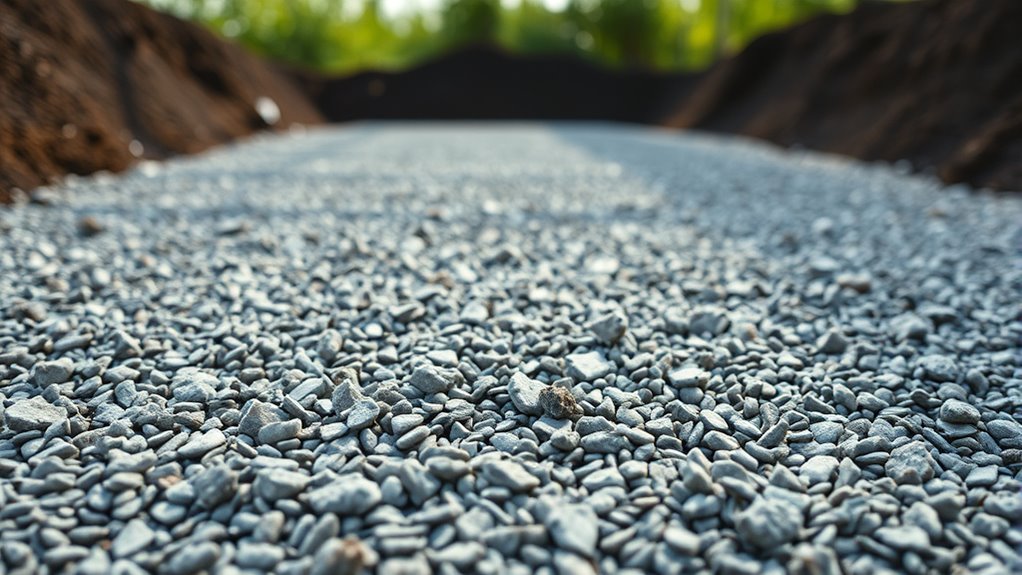
Have you considered gravel bed foundations for your greenhouse? They’re an excellent choice if you want ideal soil drainage, which keeps your plants healthy and prevents waterlogging.
Gravel allows excess water to flow away quickly, reducing the risk of root rot and other issues caused by standing moisture. Additionally, gravel beds promote better airflow underneath, aiding ventilation systems by helping to regulate temperature and humidity levels naturally. Proper drainage is essential for plant health and can greatly contribute to the longevity of your greenhouse. Incorporating gravel beds can also help prevent soil compaction, ensuring roots can grow freely and access nutrients efficiently. The loose, permeable nature of gravel enhances soil aeration, which is crucial for healthy root development. This setup ensures a stable foundation that minimizes soil compaction and provides a level surface for your greenhouse structure. Gravel is also easy to install and maintain, making it a practical option for DIY enthusiasts. Using gravel can also help with temperature regulation, keeping the soil cooler during hot weather and protecting plant roots.
Concrete Slab Foundations
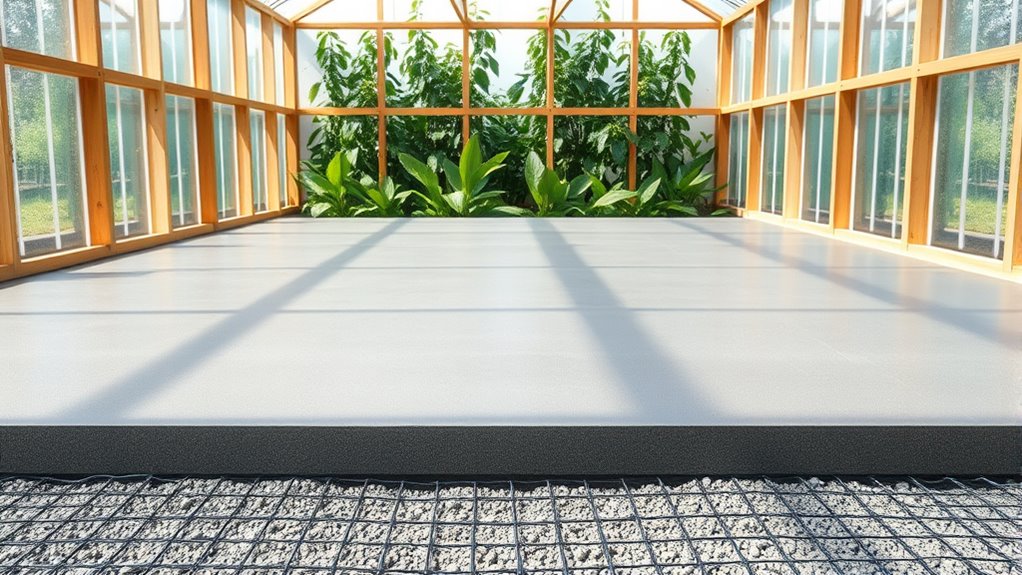
Concrete slab foundations offer a durable and stable base for your greenhouse, providing a solid surface that minimizes shifting and settling over time. Before pouring the slab, soil testing is essential to assess the ground’s load-bearing capacity and identify any issues that could cause uneven settling. Proper drainage planning is also critical; you want to ensure water flows away from the slab to prevent moisture buildup and potential damage. Incorporate a slight slope or drainage system to manage runoff effectively. A well-prepared site with thorough soil testing and effective drainage planning results in a long-lasting, stable foundation that supports your greenhouse’s structure and plants. Additionally, understanding drainage planning can help prevent water-related issues that compromise the foundation’s integrity, especially when considering vetted small wood stoves that also require proper placement for safety and efficiency. Proper foundation inspection ensures that the concrete slab remains intact and safe over time. This process is also linked to understanding dream symbolism and meanings, which can help guide your project planning with insights into underlying concerns or desires. Conducting a thorough site assessment can also identify potential soil issues early, reducing the risk of future foundation problems. This approach reduces maintenance needs and enhances the overall longevity of your greenhouse.
Pier and Beam Foundations
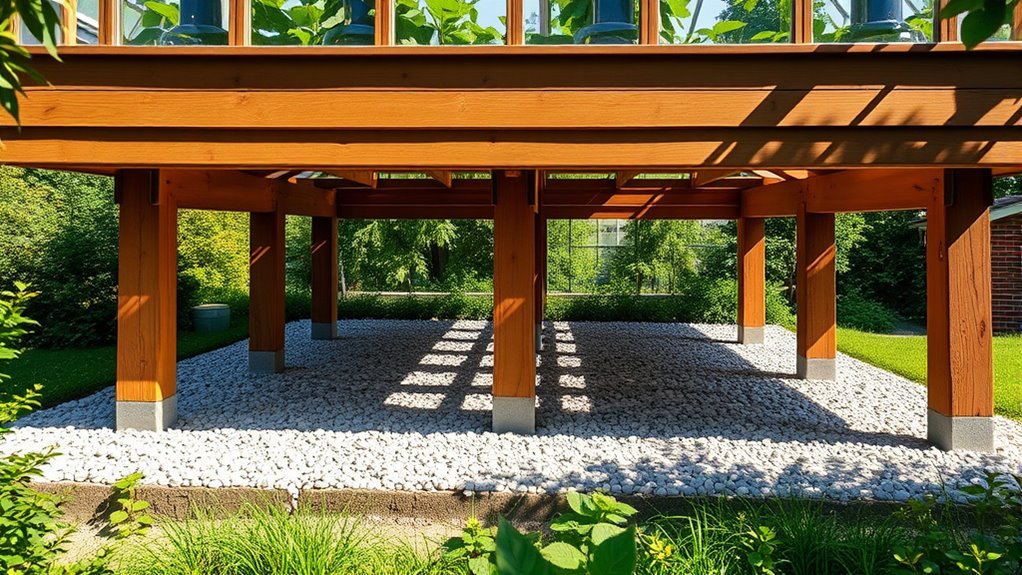
Why choose a pier and beam foundation for your greenhouse? This option allows you to elevate your structure, reducing moisture issues and providing excellent ventilation. Proper soil preparation is essential; you’ll need to ensure the ground is stable and well-drained to prevent shifting or settling. Pier and beam foundations are adaptable to various climate considerations—especially in areas prone to frost or heavy rainfall—by adjusting pier height or material. They also make access for utilities easier and simplify maintenance. Keep in mind, this foundation type works best on soils with good load-bearing capacity. Additionally, incorporating sustainable materials can enhance the eco-friendliness of your foundation, and understanding the dynamic relationship between soil stability and foundation choice can lead to more durable construction. Considering climate-related factors is crucial when selecting the appropriate foundation type for your region. Proper planning can also help you optimize space utilization and ensure long-term stability for your greenhouse. Being aware of Gold IRA investment options can help diversify your portfolio even in sustainable projects, ensuring financial stability alongside your eco-friendly structures.
Wood Frame and Skid Foundations
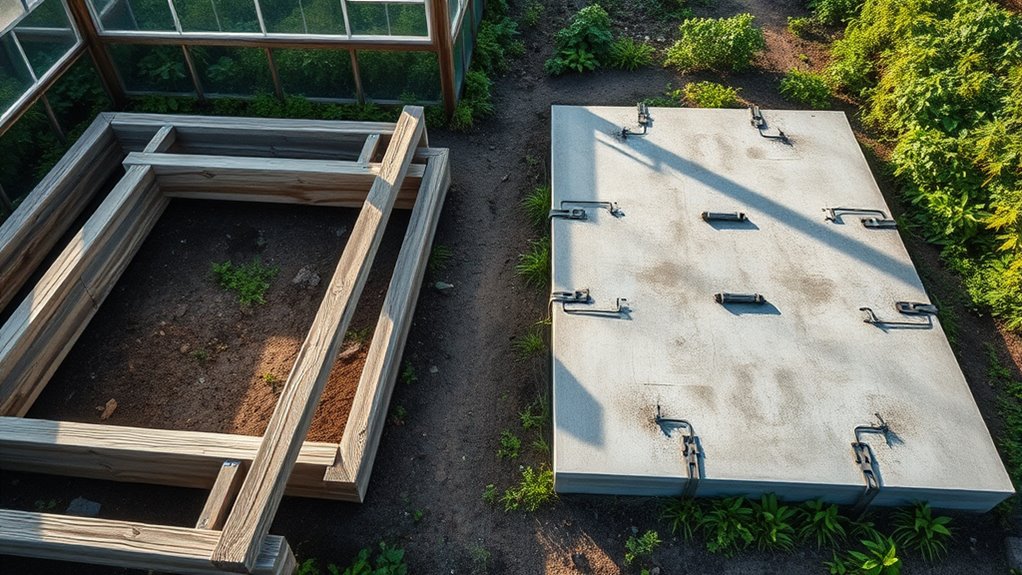
Wood frame and skid foundations offer a straightforward, cost-effective way to set up your greenhouse. They provide decent foundation stability, especially on level ground, and are simple to install. You can customize the size and shape easily to fit your space. Incorporating high-end materials can further enhance the durability and appearance of your foundation, adding a touch of luxury to your greenhouse setup. Additionally, understanding self watering plant pots can be beneficial for managing plant hydration within your greenhouse environment. Keep in mind insulation considerations, as wood can help insulate the structure but may require additional measures for cold climates.
Picture this:
- Wooden beams or skids laid directly on the ground or on gravel for support
- Use of pressure-treated lumber to resist moisture and pests
- Easy access for repairs or modifications later
These foundations are ideal for small to medium greenhouses and offer flexibility without sacrificing stability when properly constructed.
Raised Bed and Modular Foundations
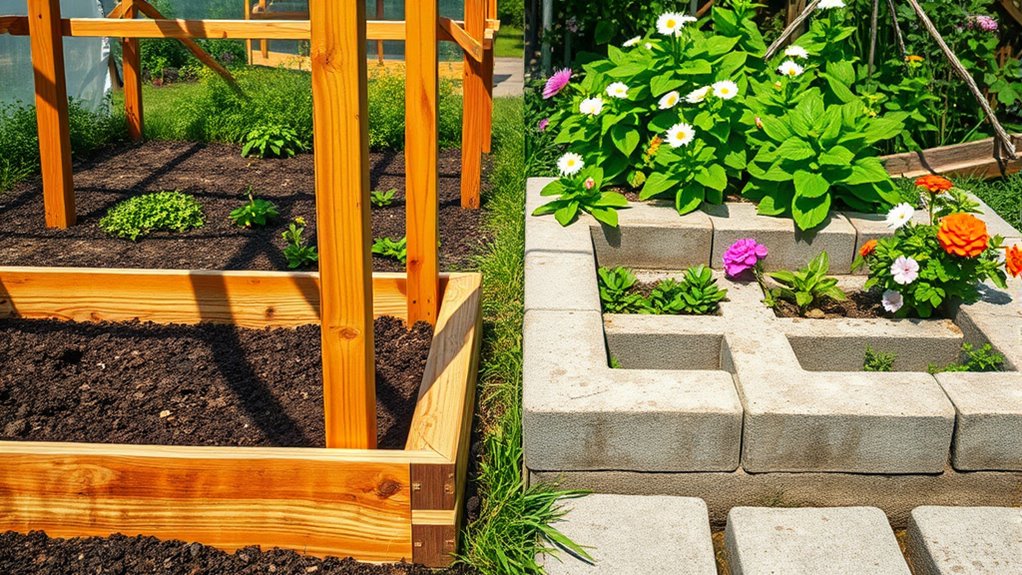
Have you considered raised bed and modular foundations for your greenhouse? These options simplify soil preparation, as you can build on level, stable surfaces without disturbing the existing ground. Raised beds help improve drainage and prevent waterlogging, promoting healthy plant growth. Modular foundations are versatile and easy to assemble, allowing you to customize the size and layout of your greenhouse. They also offer enhanced wind resistance by providing a sturdy, anchored base that withstands strong gusts. This stability reduces the risk of shifting or damage in stormy conditions. Additionally, raised beds and modular systems make maintenance easier, keep pests out, and improve overall climate control inside your greenhouse. Incorporating diverse designs can further enhance the aesthetic appeal and functionality of your greenhouse foundation. Choose these foundations if you want a durable, adaptable, and wind-resistant structure that simplifies setup and ongoing care.
Frequently Asked Questions
Which Foundation Type Best Suits Different Greenhouse Sizes?
When choosing a foundation for your greenhouse, consider its size and weight. For smaller structures, a simple concrete slab works well, providing stability and even load distribution.
Larger greenhouses need stronger foundations like pier or strip footings to guarantee soil stability and proper load transfer.
Assess your soil type and greenhouse dimensions carefully to select the best foundation, ensuring safety, durability, and long-term performance.
How Do Climate Conditions Influence Foundation Choice?
Climate conditions are the compass guiding your foundation choice. If you face heavy rains, good drainage is your best friend, preventing water damage.
In areas with unstable soil, you’ll need a sturdy foundation to keep your greenhouse steady—like a ship anchoring in rough seas.
Consider soil stability and drainage requirements carefully; these factors guarantee your greenhouse stands strong, no matter the weather, protecting your plants and investment.
What Maintenance Is Required for Each Foundation Type?
You need to regularly inspect your foundation type, ensuring proper soil preparation and drainage solutions are in place.
For concrete foundations, check for cracks and seal them promptly.
For pier and beam, inspect supports and vents, keeping soil dry and stable.
Raised beds require monitoring for erosion, while gravel bases need compaction checks.
Proper maintenance keeps your greenhouse stable and extends its lifespan by preventing water damage and soil shifting.
Can Foundations Be Customized for Specific Plant Needs?
Imagine a tailor fitting a suit—your greenhouse foundations can be customized for specific plant needs. You have great customization potential with plant-specific foundations, allowing you to optimize drainage, stability, and soil conditions for each plant type.
This flexibility means you can adapt the foundation design to support delicate seedlings or hardy perennials, ensuring your plants thrive.
What Is the Typical Installation Timeline for Each Foundation?
You’ll find that installation timelines vary based on the foundation type, but generally, poured concrete foundations take about a week.
While pier and beam setups might need a few days. Consider foundation durability and installation costs when planning; durable foundations might take longer but save money over time.
You should allocate time for preparation, curing, and inspections, ensuring your greenhouse’s foundation is solid and ready for construction.
Conclusion
Choosing the right foundation for your greenhouse means considering durability, stability, and your specific needs. Whether you opt for gravel, concrete, pier and beam, wood frame, or raised beds, each offers unique benefits. Remember, the right foundation supports growth, provides stability, and guarantees longevity. By selecting thoughtfully, you create a sturdy base that sustains your plants, your efforts, and your future harvests—building a foundation that lasts, a foundation you can rely on, a foundation for success.



